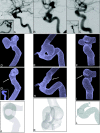Hemodynamics in a cerebral artery before and after the formation of an aneurysm
- PMID: 16687554
- PMCID: PMC7975719
Hemodynamics in a cerebral artery before and after the formation of an aneurysm
Abstract
Using data obtained from 3D digital subtraction angiography acquisitions, computational fluid dynamics techniques were used first to assess hemodynamic factors in geometrically correct models of 3 paraclinoid aneurysms and then again for assessment after virtual removal of the aneurysms and reconstruction of the parent artery. Simulations revealed an area of relatively low and rotating wall shear stresses at the location at which each aneurysm had developed. This phenomenon, to our knowledge, has not been previously described.
Figures





References
-
- Inci S, Spetzler RF. Intracranial aneurysms and arterial hypertension: a review and hypothesis. Surg Neurol 2000;53:530–40; discussion 40–42 - PubMed
-
- Krex D, Schackert HK, Schackert G. Genesis of cerebral aneurysms–an update. Acta Neurochir (Wien) 2001;143:429–48; discussion 48–49 - PubMed
-
- Kar B, Delgado RM 3rd, Radovancevic B, et al. Vascular thrombosis during support with continuous flow ventricular assist devices: correlation with computerized flow simulations. Congest Heart Fail 2005;11:182–87 - PubMed
-
- Ku DN. Blood flow in arteries. Annu Rev Fluid Mech 1997;29:399–434
MeSH terms
LinkOut - more resources
Full Text Sources
Other Literature Sources
Medical
